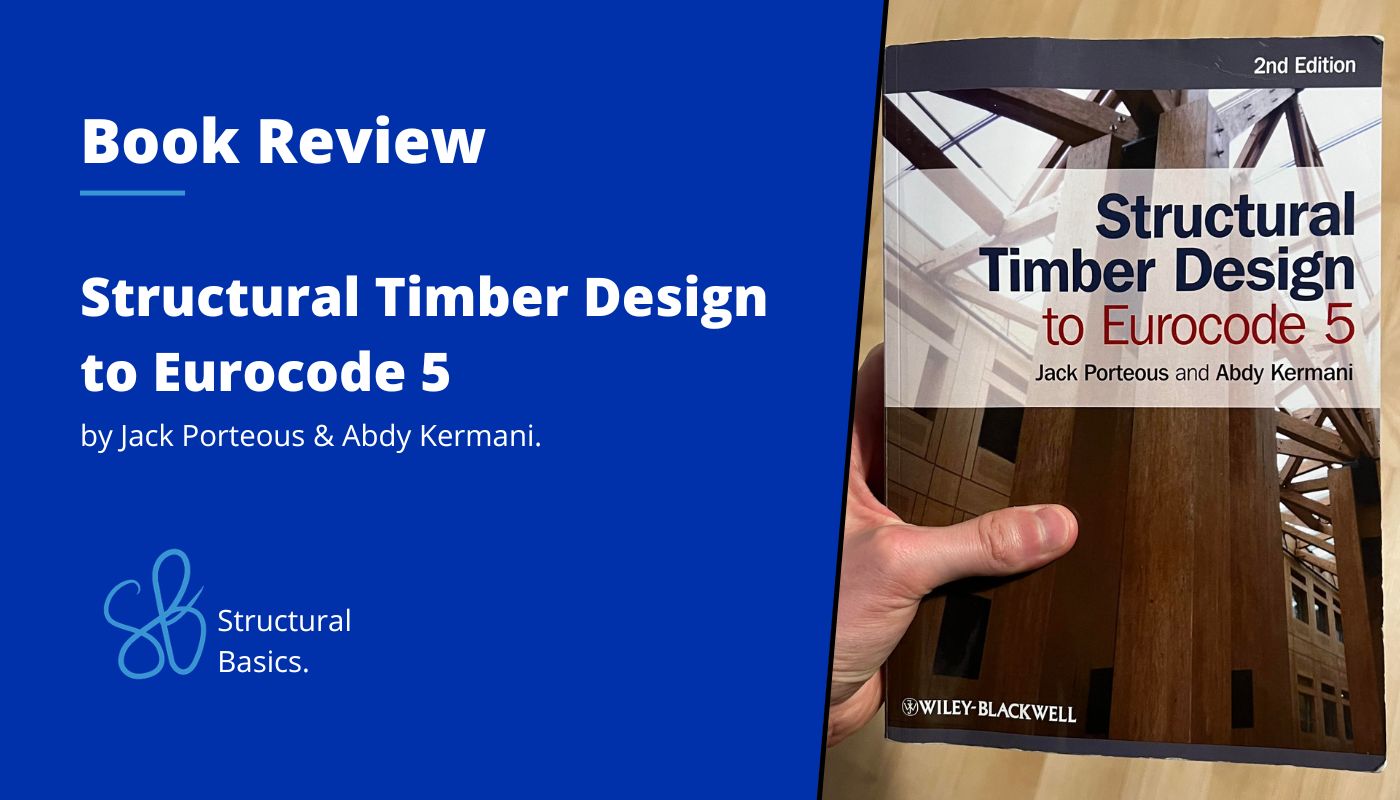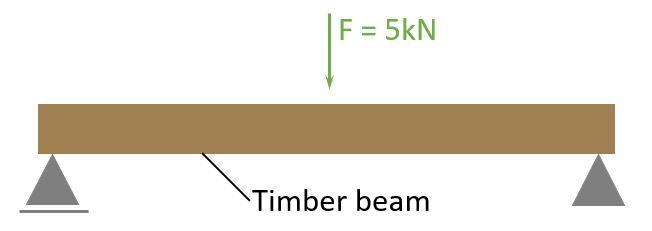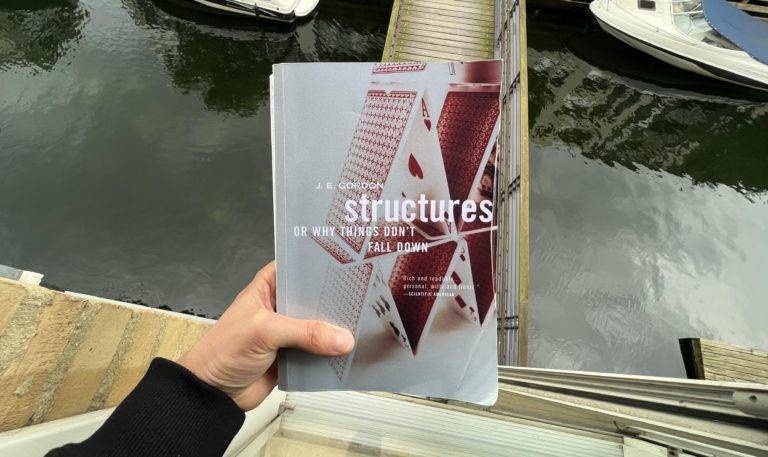Structural Timber Design to Eurocode 5 – Notes & Thoughts

This book is my Google for Timber Design.
Table of Contents
📖 The Book in a Few Words
- The book teaches structural engineers and engineering students the basics, but also covers the advanced timber design calculations. It covers everything from simply supported beams to multi-storey framed wall designs.
- All important material property tables are included (e.g. strength, stiffness and density of structural timber, different plywoods, LVL, OSB boards, $k_{mod}$ values, partial factors and many more).
- The book explains every section of Eurocode that we need to know of. Eurocode misses sometimes explanations, doesn’t it?🤔
- Best part: After each chapter, there are plenty of calculation examples.
👀 Why You Should Get It as Structural Engineer or Student
Structural Engineer, student, non-engineer or just someone interested in timber design, this book teaches you to design timber structures.
It exlains the concepts, documents all formulas you need and gives you loads of practical examples (with solutions!!) that you can practice.
This book is for you if:
- You need an all-in-one timber design guide.
- You are missing formulas in Eurocode. This book covers it!
- You are in lack of calculation examples with solutions. I know this. Many professors in university don’t provide enough examples, and some don’t even provide solutions. How should you verify your calculations, right? This book is filled with examples.🪵👍
🏗️ How It Helps Me in Timber Design
- Formulas that are missing in Eurocode are covered (and!!) explained in this book.
- It explains all contents of Eurocode outside EC5 that a structural engineer needs to know to design timber structures (e.g. Load combinations, limit state design, characteristics of timber, etc.).
- It’s my go-to-resource when I am designing something I haven’t designed before. That was the case for a dowel connection, or a roof diaphragm.
☘️ 3 Important Formulas
I like structure. That’s why I use the same headings in this book review as I did for the previous post.
But 3 Important formulas might sound strange for a design book with probably 500+ formulas, doesn’t it?
It might! But I like to see this section as general information of the topic – timber design.
So we’ll look at 3 important formulas of timber design.
Footstep induced vibrations (p. 138):
\begin{equation}
f_1 = \frac{\pi}{2l^2} \cdot \sqrt{\frac{EI}{m}}
\label{eq:vibration}
\end{equation}
Where
- l = length of floor beams
- EI = flexural rigidity of floor perpendicular to span direction
- I = Moment of inertia
- m = Mass per unit area of floor
Let me tell you a little story about this vibration equation. It might show you how different the Codes are applied in different countries.
I got introduced to the vibration verification of floors in my bachelors in Austria. It’s covered by the extensive Austrian national annex.
However, when I moved to Denmark for my masters, it took me a couple of hours researching and writing e-mails to figure out that the vibration verification is not covered by the Danish national annex and therefore not a requirement.
Since then, I have recognized many differences between the Austrian, Danish and German (I am German and have worked in Germany) codes.
Have you had a similar experience? Let us know in the comments✍️.
Compression perpendicular to timber grain (p.128)
Timber is a strong material if the load is applied parallel to the grain. But..
It’s very very weak if the load is applied perpendicular to the grain.
This is the case if a point load is applied somewhere perpendicular to a beam.

This is different to steel and concrete. So we should not forget about this verification.
\begin{equation}
\sigma_{c.90.d} = k_{c.90} \cdot f_{c.90.d}
\label{eq:compression}
\end{equation}
Where
- $\sigma_{c.90.d} = \frac{F_{c.90.d}}{A_{ef}}$
- $F_{c.90.d}$ = Load on the beam
- $A_{ef}$ = Effective contact area (perpendicular to load)
- $k_{c.90}$ = Modification factor
- $f_{c.90.d}$ = Compressive design strength of timber perpendicular to grain
Buckling (p.176)
\begin{equation}
\frac{\sigma_{c.0.d}}{k_{c.y} f_{c.0.d}} + \frac{\sigma_{m.y.d}}{f_{m.y.d}} + k_m \frac{\sigma_{m.z.d}}{f_{m.z.d}} < 1
\label{eq:euler1}
\end{equation}
and
\begin{equation}
\frac{\sigma_{c.0.d}}{k_{c.z} f_{c.0.d}} + k_m \frac{\sigma_{m.y.d}}{f_{m.y.d}} + \frac{\sigma_{m.z.d}}{f_{m.z.d}} < 1
\label{eq:euler2}
\end{equation}
Where
- $\sigma_{c.0.d}$ = Design compressive stress
- $k_{c.y}/k_{c.z}$ = Buckling reduction coefficients
- $f_{c.0.d}$ = Design compressive strength of timber
- $\sigma_{m.y.d}$ = Design bending stress
- $f_{m.y.d}$ = Design bending strength of timber
- $k_m$ = Factor for Cross-section shape
🏫 7 Things I Learned/ Use it for
- Did you know that the wider the annual rings, the more likely it is that their density is reduced, which is an indicator for reduced strength?🙋♂️ (p.6)
- Strength tables: I often don’t remember which code is used for which type of wood. This book covers all types of woods and their strength values (e.g. structural timber, plywood from different countries, LVL, and many more) (p.14+35). It even references the Code where it is taken from, so you can easily also check out the code.
- Main difference of soft- and hardwoods: Softwoods grow much quicker, therefore often felled after 30 years. Softwoods are of lower density and strength compared to hardwoods, which often take over 100 years to mature.🪵 (p.4)
- Timber connection design can be complicated. I like to read the well written explanations (p.383-554) and look at examples at the end of the chapters. (p.437-472, 491-503, 526-554)
- Buckling is a tricky one when you are still in university because there are different types of buckling and therefore also different formulas. So a general explanation of what lateral torsional buckling is, followed by a practical example, makes us understand it quicker. (p.158-215)
- I can’t promote enough how much digital hand calculations improve your design💻. It’s more readable for other people, and changes are made in seconds. The authors dedicated a whole chapter to introducing Mathcad (p.100-106). We have written an extensive How to get started article about SMath which is similar to Mathcad but free. Check it out here.
- In structural engineering, we work with loads of parameters. And sometimes we are used to using certain values of parameters, but we forget what the parameters stand for. In timber design, these parameters are for example the partial factor $\gamma_M$ or the modification factor $k_{mod}$. You can of course read up on these topics in the book.📖
🧠 More Information
If you are a bookworm like me, I highly recommend getting the book Structures: Or Why Things Don’t Fall Down from J.E. Gordon.🔥
The author explains structural engineering used in everyday items and teaches about important structural engineers.👴
Check out our Notes & Thoughts.
If you are interested in structural guides – how to design structural elements, then those blog posts might be interesting to you:
